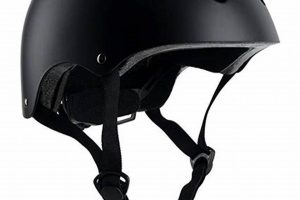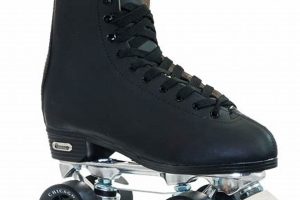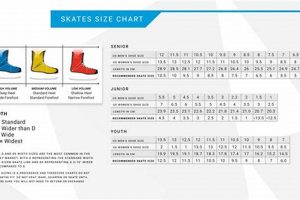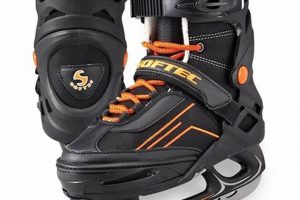Durable denim trousers designed for skateboarding activities feature a relaxed fit to allow for a full range of motion. Reinforcements at stress points, such as the knees and crotch, enhance longevity, making them suitable for the demands of frequent riding and trick execution. An example includes a pair of loose-fitting, straight-leg denim pants with reinforced stitching throughout.
The specific design offers functional advantages to skateboarders. The looser cut prevents restriction during complex maneuvers, while the robust construction withstands abrasions from falls and contact with the board. Historically, these garments evolved from workwear, adapting to the needs of a subculture requiring resilient and comfortable clothing. This adaptation has influenced both style and performance within the skateboarding community.
The following discussion will delve into specific aspects, including material composition, fit variations, popular brands, and care instructions. Further, it will examine the evolving trends and styling options available within the broader category of skateboarding apparel.
Essential Considerations for Durability and Performance
Maximizing the lifespan and functionality of specialized skateboarding denim requires careful attention to various factors. The following guidelines provide insight into selecting, maintaining, and optimizing apparel for this activity.
Tip 1: Prioritize Reinforced Construction: Examine key stress areas, such as the knees, seat, and inseam. Double or triple stitching, along with the addition of reinforcing patches, significantly enhances resistance to wear and tear.
Tip 2: Opt for Durable Denim Weight: A heavier denim weight, typically in the 12-14 ounce range, offers increased abrasion resistance compared to lighter fabrics. This increased weight will reduce the risk of tears and holes during impact.
Tip 3: Choose a Relaxed or Straight Leg Fit: A looser fit provides greater freedom of movement, essential for executing tricks and maintaining comfort during extended periods of riding. Avoid overly tight or restrictive styles.
Tip 4: Consider Blended Fabrics for Flexibility: While traditional denim provides durability, a small percentage of elastane or other stretch fibers can improve flexibility without compromising robustness. Check the fabric composition label to confirm the blend.
Tip 5: Implement Proper Washing Techniques: Turn the garment inside out before washing to minimize fading and abrasion. Utilize a gentle cycle with cold water and avoid harsh detergents or bleach. Air drying is recommended to preserve the fabric’s integrity.
Tip 6: Repair Damage Promptly: Address rips or tears as soon as they appear to prevent further damage. Professional repairs or home mending with heavy-duty thread can extend the garment’s usable life.
Tip 7: Rotate Multiple Pairs: Alternating between several pairs reduces the overall wear on each garment. This practice will prolong the lifespan of individual items and offer style variety.
By adhering to these guidelines, skateboarders can ensure their apparel provides the necessary protection, comfort, and longevity required for optimal performance and extended use.
The subsequent section will explore the style and fit considerations in more detail, further refining the selection process for this specific type of apparel.
1. Reinforced construction
Reinforced construction constitutes a critical design element in durable denim apparel designed for skateboarding. This feature directly addresses the heightened stress and abrasion inherent in the activity. Skateboarding involves frequent contact with abrasive surfaces, such as concrete and asphalt, which subjects clothing to significant wear and tear. Failure to incorporate reinforcement measures in these garments directly results in premature failure and reduced garment lifespan. For example, standard denim trousers lacking reinforced knees will quickly develop holes during skateboarding, rendering them unsuitable for continued use.
The importance of reinforced construction manifests in several specific design adaptations. Double or triple stitching along seams, particularly in high-stress areas like the knees, seat, and inseam, provides increased resistance to tearing and separation. Gusseted crotches, reinforcing panels added to the inseam, prevent blowouts caused by the wide range of motion involved in skateboarding maneuvers. Patches made from durable materials, such as canvas or leather, applied to the knees or other vulnerable areas further enhance resistance to abrasion. Certain brands are known for using Cordura fabrics, which offer great tensile strength and abrasion resistance, as reinforcement layers. These strategic reinforcements collectively mitigate the impact of repetitive stress and impact on the apparel.
In summary, reinforced construction is not merely an optional feature but an essential component that determines the suitability of denim for skateboarding. Without such reinforcements, these garments would rapidly degrade under the harsh conditions of the sport. Understanding the principles of reinforced construction allows consumers to make informed purchasing decisions, prioritize durability, and maximize the lifespan of their skateboarding apparel. The selection and maintenance of appropriate garments directly impact the cost-effectiveness and overall enjoyment of the activity.
2. Durable denim weight
Denim weight is a crucial factor in determining the suitability of denim trousers for skateboarding activities. Heavier denim fabrics offer increased resistance to abrasion and tearing, extending the lifespan of the garment and providing enhanced protection for the wearer. The selection of appropriate denim weight directly correlates with the durability and performance of such apparel.
- Abrasion Resistance
Heavier denim, typically in the range of 12 to 16 ounces per square yard, possesses a tighter weave and thicker yarn construction, resulting in superior abrasion resistance. This characteristic is essential for withstanding the repeated friction encountered during skateboarding, such as falls and contact with the board. Lighter denim fabrics are more susceptible to tearing and wear under similar conditions.
- Impact Protection
While not providing substantial impact protection, the added mass of heavier denim offers a degree of cushioning against minor impacts. This can reduce the severity of abrasions and contusions resulting from falls. Thicker denim acts as a barrier, dispersing force and minimizing direct contact between the skin and the abrasive surface.
- Longevity and Cost-Effectiveness
The increased durability of heavier denim translates to a longer garment lifespan. While initial costs may be higher compared to lighter-weight options, the reduced frequency of replacement makes heavier denim a more cost-effective choice in the long run. Skateboarders who engage in frequent riding and trick execution benefit significantly from this increased longevity.
- Stiffness and Comfort Considerations
Heavier denim can initially feel stiffer and less comfortable than lighter-weight alternatives. However, with wear and washing, the fabric softens and conforms to the body. Manufacturers often employ techniques such as pre-washing or sanforization to minimize initial stiffness. A proper fit, with adequate room for movement, is crucial to maximize comfort when using heavier denim.
The selection of appropriate denim weight involves balancing the need for durability with considerations of comfort and initial cost. The higher durability of heavier denim offers a cost-effective solution for frequent skaters, while softer, lighter denims may serve the needs of those who require only occasional skateboarding jeans. This decision depends on the intensity, frequency, and environment of activity for its suitability.
3. Relaxed fit essential
A relaxed fit is a necessary design characteristic of denim pants intended for skateboarding. The demands of the activity necessitate a full range of motion, which is directly impeded by more restrictive garment styles. Constricting clothing limits the ability to perform tricks and maneuvers effectively, impacting both performance and safety. A relaxed fit, conversely, facilitates unrestricted movement, enabling the wearer to execute complex actions without hindrance. For instance, attempting an ollie or kickflip in tight-fitting denim would be considerably more difficult and potentially dangerous due to restricted leg flexion and extension.
The functional benefits of a relaxed fit extend beyond mere maneuverability. This design also allows for greater comfort during extended periods of activity. Skateboarding often involves prolonged sessions, during which restrictive clothing can cause discomfort, chafing, and decreased blood circulation. Relaxed-fit denim minimizes these issues, promoting comfort and preventing distractions that could impair focus and increase the risk of accidents. The looser cut facilitates breathability, aiding in temperature regulation and reducing perspiration build-up, further contributing to comfort. Furthermore, the presence of extra volume around the knee and seat areas diminishes the risk of binding or tearing during high-stress movements. Brands catering to skateboarders invariably prioritize this design element in their product lines, underscoring its fundamental significance.
In summary, the relaxed fit constitutes a critical design component of denim intended for skateboarding, providing essential functionality through unrestricted movement and enhanced comfort. This design choice reflects an understanding of the specific physical demands of the activity. A failure to incorporate a relaxed fit in these garments compromises performance and increases the risk of discomfort and injury. Manufacturers and consumers should prioritize this feature when selecting skateboarding apparel, recognizing its direct correlation with both practicality and safety.
4. Flexibility and comfort
The integration of flexibility and comfort into the design of denim apparel for skateboarding directly impacts the user’s performance and overall experience. Skateboarding necessitates a wide range of motion, requiring the wearer to execute complex maneuvers such as ollies, grinds, and flips. Garments that restrict movement hinder the execution of these techniques, potentially leading to decreased performance and increased risk of injury. Therefore, flexibility is not merely a comfort consideration but a functional imperative.
Comfort, similarly, plays a pivotal role in sustaining prolonged skateboarding sessions. Ill-fitting or uncomfortable clothing can cause distractions and discomfort, reducing focus and potentially leading to fatigue. Denim that is too stiff, abrasive, or poorly ventilated can result in chafing, overheating, and restricted blood flow, all of which detract from the overall skateboarding experience. Examples of garments that fail to prioritize comfort and flexibility are those constructed from rigid, heavyweight denim with a slim or tapered fit. Such apparel restricts movement and traps heat, making it unsuitable for the demands of skateboarding. Conversely, denim with a relaxed fit, incorporating stretch fibers and breathable fabric weaves, facilitates ease of movement and improves temperature regulation, thus enhancing comfort and performance. The significance of this understanding is realized through optimized tricks that can be performed and overall skateboarding time.
In summary, flexibility and comfort are not ancillary features but core design requirements for denim worn during skateboarding. The integration of these elements directly influences performance, safety, and overall user satisfaction. Garments that prioritize flexibility and comfort allow skateboarders to execute tricks effectively, sustain longer sessions, and minimize the risk of injury, resulting in a more enjoyable and productive experience. The understanding of this cause-and-effect relationship should thus inform both manufacturing and purchasing decisions within the skateboarding apparel market.
5. Style versatility
Style versatility, in the context of skateboarding apparel, represents the capacity of a garment to integrate seamlessly into various aesthetic preferences and social settings beyond the immediate activity of skateboarding. This characteristic is particularly relevant to the selection and appeal of denim trousers, which must balance functional requirements with stylistic adaptability.
- Adaptability to Various Skateboarding Styles
Denim offers adaptability across various skateboarding sub-styles, from street skating to vert and park skating. Lighter washes and distressed finishes complement a casual street aesthetic, while darker, more durable denim is suitable for the functional demands of park and vert skating, where abrasion resistance is paramount. This adaptability permits the wearer to tailor their apparel choice to the specific type of skateboarding being practiced.
- Integration into Casual Wardrobes
Beyond the skate park, denim’s inherent versatility allows for seamless integration into everyday casual wardrobes. Pairing the garment with a simple t-shirt and sneakers creates a classic, understated look. Alternatively, combining it with a button-down shirt and boots elevates the ensemble for more formal occasions. This adaptability extends the garment’s utility beyond the realm of skateboarding, enhancing its value and practicality.
- Customization and Personal Expression
Denim provides a canvas for personal expression through various customization options. Rips, tears, patches, and embellishments can be added to reflect individual style and affiliations. This allows skateboarders to create a unique garment that reflects their identity and preferences. The capacity for customization transforms a standard garment into a personalized statement of style.
- Seasonal Adaptability
While often associated with cooler climates, denim can be adapted for year-round wear. Lighter-weight denim or denim blends incorporating breathable fibers are suitable for warmer weather, while heavier-weight denim provides insulation during colder months. The ability to adapt the garment to seasonal changes further enhances its practicality and extends its utility.
Style versatility is a significant attribute, broadening the garment’s appeal and functionality. The ability to transition from the skate park to everyday settings, to personalize the garment through customization, and to adapt to seasonal changes contributes to its enduring popularity. This versatility underscores the value of denim as a practical and stylish choice for skateboarders and non-skateboarders alike.
Frequently Asked Questions
This section addresses common inquiries regarding denim apparel designed specifically for skateboarding, offering clarity on essential features and performance considerations.
Question 1: What distinguishes denim trousers designed for skateboarding from standard denim trousers?
Denim trousers designed for skateboarding commonly incorporate reinforced stitching at stress points, such as the knees and crotch. They also feature a looser fit to accommodate the range of motion required for skateboarding maneuvers and may utilize heavier-weight denim for increased durability.
Question 2: How does denim weight influence the performance of skateboarding denim?
Heavier-weight denim, typically in the 12-14 ounce range, provides greater abrasion resistance and overall durability, which is essential for withstanding the wear and tear associated with skateboarding. Lighter-weight denim may offer increased comfort but is less resistant to damage.
Question 3: Is a relaxed fit universally preferable for all skateboarders?
While a relaxed fit facilitates a greater range of motion, individual preferences may vary. Some skateboarders may prefer a straight-leg or slim-fit style. However, it is essential to ensure adequate room for movement to avoid restriction and potential injury.
Question 4: What materials, beyond traditional cotton denim, are commonly used in the construction of skateboarding denim?
Some manufacturers incorporate stretch fibers, such as elastane, into denim blends to improve flexibility and comfort. Others utilize reinforcing materials, such as Cordura or canvas, in high-wear areas to enhance durability.
Question 5: How should denim trousers designed for skateboarding be properly cared for to maximize their lifespan?
Turning the trousers inside out before washing, using a gentle cycle with cold water, and air-drying are recommended to minimize fading and abrasion. Promptly repairing any tears or damage can also extend the garment’s usable life.
Question 6: Are specific brands recognized for producing high-quality denim apparel for skateboarding?
Several brands, including but not limited to Dickies, Levi’s Skateboarding, and Volcom, are known for their commitment to producing durable and functional denim apparel specifically designed for skateboarding. Researching reviews and product specifications can aid in selecting a reputable brand.
This FAQ section provides a foundation for understanding the key considerations when selecting denim apparel for skateboarding. Awareness of these factors empowers informed purchasing decisions.
The subsequent section will examine current trends and evolving styles within the broader context of skateboarding apparel.
Men’s Skate Jeans
This exploration has detailed the core attributes of men’s skate jeans, emphasizing the crucial elements of reinforced construction, durable denim weight, a relaxed fit, inherent flexibility, and stylistic adaptability. The analysis highlights the need for these garments to withstand the abrasive and dynamic demands of skateboarding while maintaining user comfort and accommodating personal style preferences. A comprehension of these characteristics enables informed decision-making in selecting appropriate apparel.
The continued evolution of skateboarding apparel will likely see further advancements in material science and design innovation. Skateboarders are encouraged to consider durability, functionality, and personal expression when choosing garments. These factors contribute directly to safety, performance, and the overall enjoyment of the sport.







